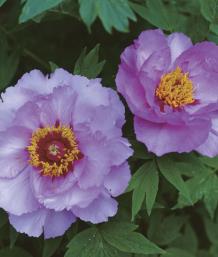
I first met Kasha at a dinner party I had for a few friends back in the early 1980s. At the end of the party, I offered her a tree peony blossom from my modest garden, hoping it might cast a romantic spell. It did. And not too long afterward, we began making plans for our wedding and the peony garden we would nurture together.
Our search for a proper garden site took more than a year. This paled in comparison to our search for plants. We specifically wanted to grow Chinese tree peonies that were not readily available in the U.S., so for years, we wrote to individuals and organizations in China. When we finally found someone, they insisted that we purchase several hundred plants. Wanting only a few of the best specimens, we scrambled to sell the rest. But through the years, our passion for tree peonies has blossomed into a full-time business.
Tree Peony
Paeonia suffruticosa
(Pay-own-ia suf-froot-i-cosa)
• Slow-growing, woody shrub that reaches 4 to 10 feet tall and displays large, silken blossoms.
• Adaptable to USDA Hardiness Zones 3 to 9 (–40°F to 20°F).
• Flowers best in dappled shade, with three to four hours of sun.
• Requires excellent drainage, so plant on a hillside or in a raised bed with plenty of organic matter.
• Enrich soil with compost, and feed with a foliar spray of seaweed or fish emulsion in spring.
Herbaceous peonies and tree peonies: Distinctly different plants
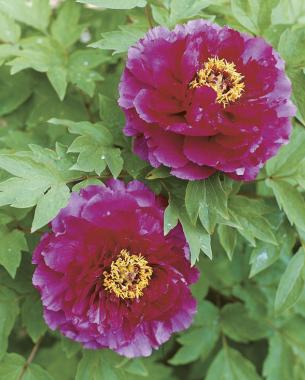
Peonies come in two basic types: herbaceous and tree forms. Herbaceous peonies grow to 4 feet, have flowers 6 inches in diameter, and are easy to propagate by division. They thrive in USDA Hardiness Zones 4 to 7 (–30°F to 0°F), and may have 40 or more flowers on a mature plant. Most bloom in early to mid-June and die back to the ground after first frost.
The tree peony, however, is a distinctly different plant. Tree peonies are woody shrubs; some grow 10 feet high without support. Their flowers—which come in a multitude of shapes, colors, and fragrances—are much larger and usually bloom two weeks earlier than herbaceous peonies. Although they lose their leaves in the fall, they maintain a graceful branching structure throughout the winter. Tree peonies can be grown in USDA Hardiness Zones 3 to 9 (–40°F to 20°F).
Tree peonies prefer dappled shade and good drainage
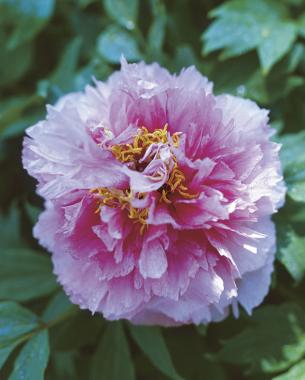
Unlike herbaceous peonies, which bloom best in full sun, tree peonies prefer partial shade, with three to four hours of sunlight. The plants grow faster in sun, but the flowers burn and vanish in a day or two. On occasion, when we do plant tree peonies in full sun to spur plant growth, we shade the blooms with a parasol or cloth awning, which rewards us with blooms that last a week to 10 days.
Tree peonies need a well-drained location, such as a hillside; standing water will kill them. And while they are not particular about soil acidity, a pH range of 6.5 to 7.0 is ideal.
Unlike herbaceous peonies, tree peonies do not require a freezing period to bloom, but rather a rest period of several weeks with temperatures of 35°F to 40°F. For this reason, they thrive as far south as Tuscaloosa, Alabama. They are hardy as far north as southern Minnesota, where winter temperatures can fall to –30°F.
Tree peonies: Diversity is their hallmark
Tree peonies are classified as Chinese, Japanese, European and American hybrids, and Itoh or intersectional hybrids. Tree peonies are generally considered derived from the species Paeonia suffruticosa. However, peony taxonomy is a complex subject, and lately there is a growing body of evidence that Chinese tree peonies may actually be descendants of two or three species. In the nursery trade, cultivar names are most easily recognized and appreciated. After all, one can only delight in names like ‘White Light in the Night’, ‘Amber Moon’, ‘Tiger Tiger’, ‘Necklace with Precious Pearls’, ‘Princess Zhao Marries Beyond the Great Wall’, Intoxicated Celestial Peach’, ‘Coiled Dragon in the Mist Grasping a Purple Pearl’, ‘Great Winged Butterfly’, and ‘Taoist Stove Filled with Pills of Immortality’.
Chinese tree peony diversity
The Chinese tree peony, or mudan, has been the favorite flowering plant in China since the 7th century Sui Dynasty. In fact, its popularity has been likened to the tulip craze that swept Holland in the 17th century.
The Chinese describe their mudan flowers as silky, and we agree. While some blossoms reach 1 foot in diameter, most average 8 to 10 inches. Of all the tree peonies, the Chinese cultivars offer the most diversity. Flowers may be white, pink, red, magenta, maroon, violet, shades of these colors, or multicolored. Some flower petals are darker toward the center, while others have frosted tips. As light falls on the petals, their colors often change before your eyes, softening in the sunlight. Light yellow flowers fade to white; dark purple petals turn to lavender.
Flower shapes are broadly classified as single, semidouble, or double. But within these classifications, there is much variation. We have grown the single, light semidouble, heavy semidouble, double, ruffled ball, thousand petal, crown, and rumpled forms. Furthermore, blossoms may be up-facing, side-facing, or down-facing. We believe each has a place in the garden.
Many Chinese tree peonies are fragrant, with scents ranging from sweet to spicy, sometimes even woodsy. One of our favorites, ‘Grand Duke Dressed in Blue and Purple’, has such a delicious aroma it defies description. Let’s just say that if heaven had a candy shop, that’s what it would smell like. Altogether, the Chinese recognize more than 600 cultivars of tree peonies; we grow about 80 of them in our Connecticut garden.
Japanese tree peony availability
In the 8th century, the Chinese introduced the Japanese to the tree peony as a medicinal plant. It was presented to Japan again in the 17th century, this time for its beauty. In our opinion, many of today’s Japanese tree peonies are actually Chinese tree peonies, because in the 400 intervening years, the plants have not changed.
Of course, there are exceptions. One is ‘Island Brocade’, a branch mutation of ‘The Sun’. It produces stunning pink and red variegated flowers. The Japanese, for their own aesthetic reasons, grow only single and semidouble cultivars, which bloom about a week after the Chinese mudans.
Of all the tree peonies, Japanese cultivars are the most readily available in the United States. They can be purchased through mail-order sources, as well as at local garden centers.
Hybrids emerge in the West
Around 100 years ago, a new species with small, yellow flowers (Paeonia lutea) was introduced to the West. Over the years, it has been hybridized with semidouble varieties throughout Europe and the U.S. In the U.S., this hybridization was done by A.P. Saunders, and many plants now carry his name. Flowers are smaller, often side-facing or down-facing, with a lovely, citrus-vanilla fragrance. They bloom later than either the Chinese or Japanese tree peonies, thus extending the bloom season for tree peonies.
In their second generation of hybridization, led by Nassos Daphnis and David Reath, the flowers are larger and the color palette expanded. Flowers with yellow undertones like ‘Redon’ and ‘Exotic Era’ are much sought after.
A botanical curiosity
About 30 years ago, a Japanese hybridizer named Toichi Itoh succeeded in crossing tree peonies with herbaceous peonies—adding new colors and shades to the peony palette. A botanical curiosity, these intersectional or Itoh hybrids have the leaves and flowers of tree peonies, but die back to the ground in the fall like herbaceous plants.
Plant peonies in the fall
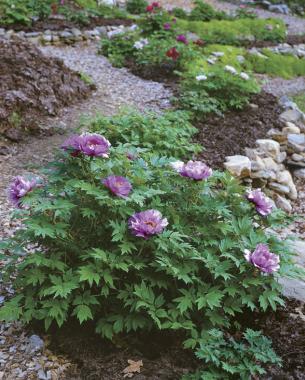
Fall is the time to plant and move all peonies. Plant your tree peonies at least six weeks before the ground freezes; spring planting simply does not allow time for roots to develop, so they are unable to support emerging foliage. As a result, spring-planted peonies often weaken or die, giving them an undeserved reputation of being hard to grow.
To plant tree peonies, dig a hole about 2 feet in diameter and in depth. Build a hill in the middle of the hole and spread the tree peony’s roots over it. Use good garden soil with plenty of organic matter to refill the hole, watering thoroughly when half filled and finished. Make sure all shoots are underground; it’s actually difficult to plant tree peonies too deeply. And remember, tree peonies can grow to considerable size, so space holes about 5 feet apart. If plants are subject to heaving in your climate, it’s smart to mulch your peonies the first year.
Tree peonies are heavy feeders

Since tree peonies have a lot of leaves and large flowers, they tend to be heavy feeders. Although we don’t fertilize them at planting time, we do feed them with compost in subsequent years. With the exception of fresh manures, which need time to break down, any available compost should do.
Rather than layering the compost on top of the soil, we dig a 1-foot-deep and 1-foot-wide trench along the drip line of the plant, and fill it with the compost. In a year or two, once roots have grown into the trench, we repeat the process further out. Each spring, we also feed our tree peonies with a foliar spray, such as seaweed or fish emulsion. After blooming, we water the plants with this same solution.
Tree peonies are plants with enormous vitality. Even if you run over them with a lawn mower, they’ll usually come back. With proper care, they’re virtually pest- and disease-free. After blooming, we deadhead the flowers, and in the fall, we take all the fallen leaves away. This cleanup helps prevent botrytis from infecting the plants in the spring.
We know of only one insect pest that preys on tree peonies: the rose borer. It works its way into the pith of older plants and deposits its eggs from spring to fall. If you see its telltale hole or a wilted branch, cut away the affected wood.
Older plants provide the blooms
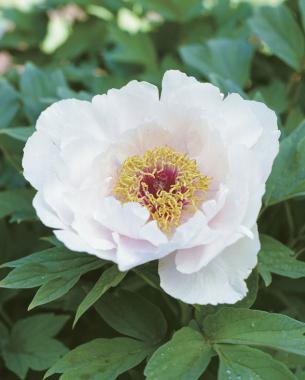
Young tree peonies do not bloom. For this reason, we recommend that you purchase plants at least three years old for a first or second year show of color.
There’s another good reason to purchase plants. Tree peonies are difficult to propagate. Although many single and semidouble cultivars produce fertile seeds, the offspring often revert to the species, losing the desired characteristics of the parent plants. Even if they don’t, it can take up to seven years for a plant grown from seed to produce flowers.
The most widely accepted method of propagation is grafting new stem growth, or scions, onto root stock. Another method, with which we have had some success, is branch layering. It’s relatively easy to propagate low-growing and spreading plants, but is not an option for upright varieties.
While tree peonies may be challenging to propagate, established plants are easy to grow. They require little attention, yet can provide years of beautiful, fragrant flowers.
—David Furman and his wife, Kasha (who contributed to this article), collect, grow, and sell Chinese tree peonies at Cricket Hill Garden in Thomaston, Connecticut.

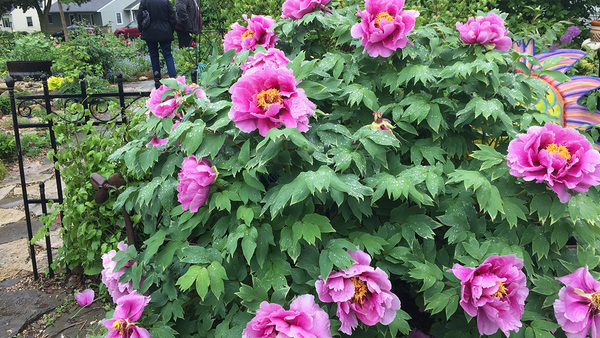
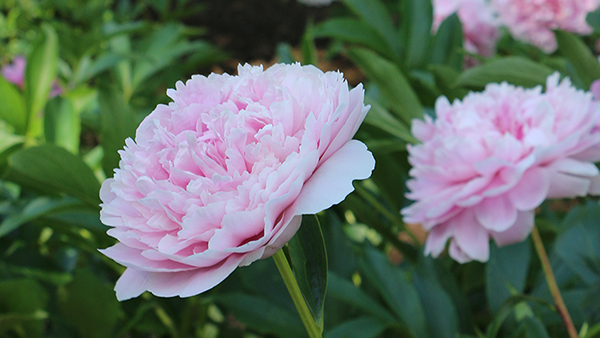
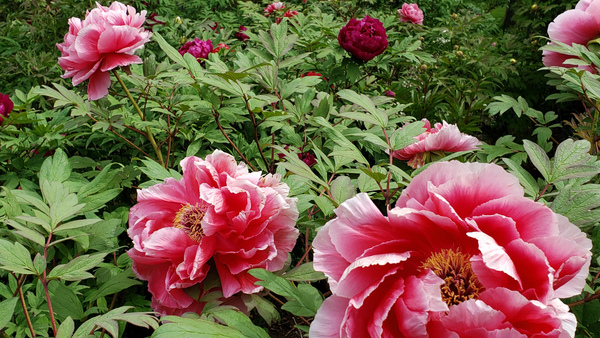
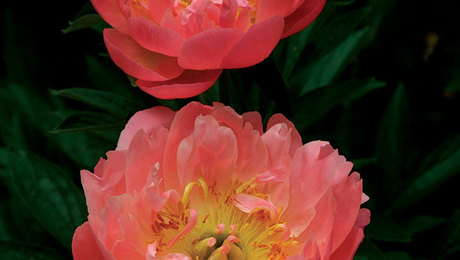

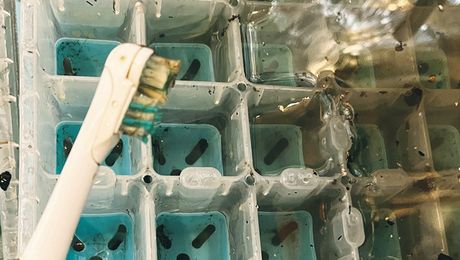










Comments
Hi,
I absolutely love my peonies, they create such a wonderful, fragrant flower that lasts for well over a week it seems when cut and vased.
My question: I do believe I have HERBACEOUS PEONIES since they are living on the north side of my home, and barely get 3-4 hours of sun each day. However, I just read on another site that HERBACEOUS PEONIES require full sun.
Anyone can confirm that HERBACEOUS PEONIES can actually live in 3-4 hours of sun/day. Evidently mine do.
Ron
Thank you for your post! I inadvertently planted my Herbaceous Peonies in a shady section of my garden, not realizing that my rose bush would block most of the morning sun. I'm glad to know your peonies are thriving in the shade, since I just planted mine this past spring and did not want to transplant the bush to a more sunny spot. It has suffered through white powdery mildew and blackened leaves; however, it does continues to grow, albeit slowly. You have given me hope that maybe my peonies will survive. :-)
Very informative article, thanks for posting.
Log in or create an account to post a comment.
Sign up Log in